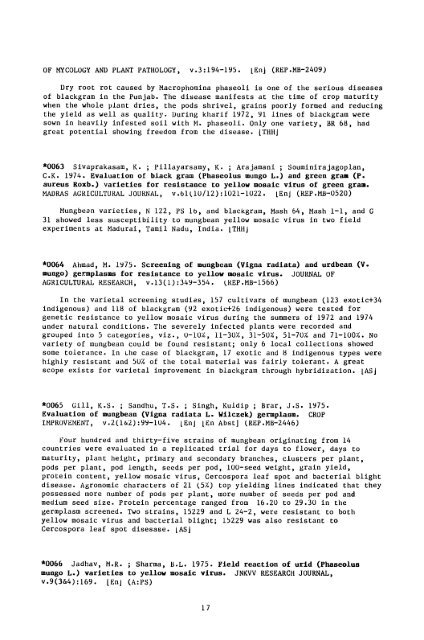PNABD246.pdf
PNABD246.pdf
PNABD246.pdf
Create successful ePaper yourself
Turn your PDF publications into a flip-book with our unique Google optimized e-Paper software.
OF MYCOLOGY AND PLANT PATHOLOGY, v.3:194-195. [En] (REP.MB-2409)<br />
Dry root rot caused by Macrophomina phaseoli is one of the serious diseases<br />
of blackgram in the Punjab. The disease manifests at the time of crop maturity<br />
when the whole plant dries, the pods shrivel, grains poorly formed and reducing<br />
the yield as well as quality. During kharif 1972, 91 lines of blackgram were<br />
sown in heavily infested soil with M. phaseoii. Only one variety, BR 68, had<br />
great potential showing freedom from the disease. [THHJ<br />
*0063 Sivaprakasam, K. ; Pillayarsamy, K. ; Arajamani ; Souminirajagoplan,<br />
C.K. 1974. Evaluation of black gram (Phaseolus mungo L.) and green gram (P.<br />
aureus Roxb.) varieties for resistance to yellow mosaic virus of green gram.<br />
MADRAS AGRICULTURAL JOURNAL, v.bl1lU/12):1021-1022. [EnJ (REP.MB-0520)<br />
Mungbean varieties, N 122, PS ib, and blackgram, Mash 64, Mash 1-I, and G<br />
31 showed less susceptibility to mungbean yellow mosaic virus in two field<br />
experiments at Madurai, Tamil Nadu, India. [THHJ<br />
*0064 Ahmad, M. 1975. Screening of mungbean (Vigna radiata) and urdbean (V.<br />
mungo) germplasms for resistance to yellow mosaic virus. JOURNAL OF<br />
AGRICULTURAL RESEARCH, v.13(i):349-354. kREP.MB-1566)<br />
In the varietal screening studies, 157 cultLivars of mungbean (123 exotic+34<br />
indigenous) and 118 of blackgram (92 exotic+26 indigenous) were tested for<br />
genetic resistance to yellow mosaic virus during the summers of 1972 and 1974<br />
under natural conditions. The severely infected plants were recorded and<br />
grouped into 5 categories, viz., 0-10%, 11-30%, 31-50%, 51-70% and 71-100%. No<br />
variety of mungbean could be found resistant; only 6 local collections showed<br />
some tolerance. In Lhe case of blackgram, 17 exotic and 8 indigenous types were<br />
highly resistant and 50% of the total material was fairly tolerant. A great<br />
scope exists for varietal improvement in blackgram through hybridization. [AS]<br />
*0065 Gill, K.S. ; Sandhu, T.S. ; Singh, Kuldip ; Brar, J.S. 1975.<br />
Evaluation of mungbean (Vigna radiata L. Wilczek) germplasm. CROP<br />
IMPROVEMENT, v.2(1&2):99-I04. [En] [En Abst] (REP.MB-2446)<br />
Four hundred and thirty-five strains of mungbean originating from 14<br />
countries were evaluated in a replicated trial for days to flower, days to<br />
maturity, plant height, primary and secondary branches, clusters per plant,<br />
pods per plant, pod length, seeds per pod, 100-seed weight, grain yield,<br />
protein content, yellow mosaic virus, Cercospora leaf spot and bacterial blight<br />
disease. Agronomic characters of 21 (5%) top yielding lines indicated that they<br />
possessed more number of pods per plant, more number of seeds per pod and<br />
medium seed size. Protein percentage ranged from 16.20 to 29.30 in the<br />
germplasm screened. Two strains, 15229 and L 24-2, were resistant to both<br />
yellow mosaic virus and bacterial blight; 15229 was also resistant to<br />
Cercospora leaf spot disesase. [AS]<br />
*0066 Jadhav, M.R. ; Sharma, B.L. 1975. Field reaction of urid (Phaseolus<br />
mungo L.) varieties to yellow mosaic virus. JNKVV RESEARCH JOURNAL,<br />
v.9(3&4):169. [Enj (A:PS)<br />
17

















